

Positive Black Sisters Marketing Services
The page was developed exclusively to support the women of Positive Black Sisters and Black Women Authors. The pricing listed on this page is exclusive to them. There is no access to this page from our website, you can only access this page from positiveblacksisters.com.
What is SEO?

Great question. To understand SEO, you need to understand search engines. A search engine is a piece of software that crawls the Internet and indexes its pages in order to provide the best website recommendations based on a user's search query. And they use complex, ever-changing algorithms to do that.
Moz said it best, “imagine the World Wide Web as a network of stops in a big city subway system. Each stop is a unique document.” As search engine bots crawl and index web pages, links serve as bridges that let them reach the billions of interconnected pages on the Internet. From there, search engines are able to analyze and “understand” the contents of each page. When a user performs a search, they provide the best answer possible based on their algorithm specifications, ranking the results according to what they deem most relevant. It's all very impressive and can feel a little scary — but never fear, we're here to help.
The factors that search engines use to rank results include social media engagement, off-site optimization, topical authority, latent semantics, mobile friendless, local optimization, domain authority, and much more. That's where search engine optimization (SEO) comes in. SEO is the process of implementing strategies and techniques (both on site and off site) in an effort to achieve a higher rank in search results. Typically, the higher a site is in search results, the more visitors it receives.
Although there is much to learn about search engines and how to optimize for them, the following chapters will outline the steps to get you started with SEO for your BigCommerce store and, in time, help lead you to search engine domination!
Things to Know
Here are a few general items you need to be aware of when it comes to your SEO strategy.
Long Tail Keywords
When adding content to your store, like product titles and descriptions, about us and contact information, you'll want to use keywords that will make your goods or services more easily found by people searching for them.
People who already know what they want to buy use search terms that are longer and more specific than those who are just researching a product or service.
These longer, more specific searches are called long tail keywords. Having long tail keywords mixed in with the content of your site will increase your rank on search engine result pages when people search for the same terms.
For example, someone doing research on fashion trends might do a general search for "women's shoes", and will get literally millions of results. At the same time, someone who has zeroed in on what they want to buy will do a search for "sparkly red pumps size 7", and receive fewer but far more relevant results.
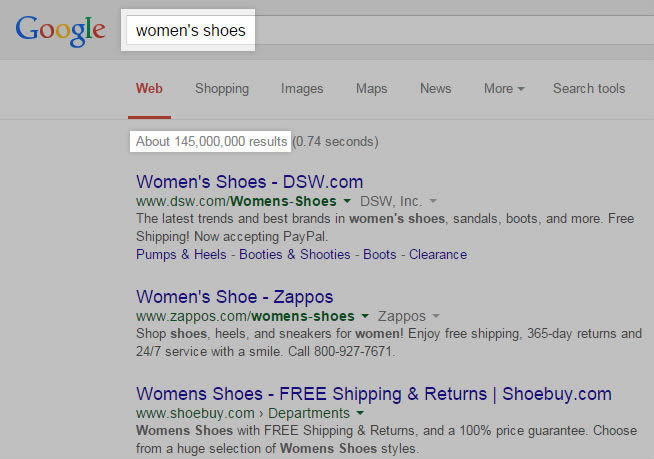
Having your products show up in this shorter, more exclusive list of search results is good because there is less competition than with the generic search, were you'd be less likely to stand out or be found.
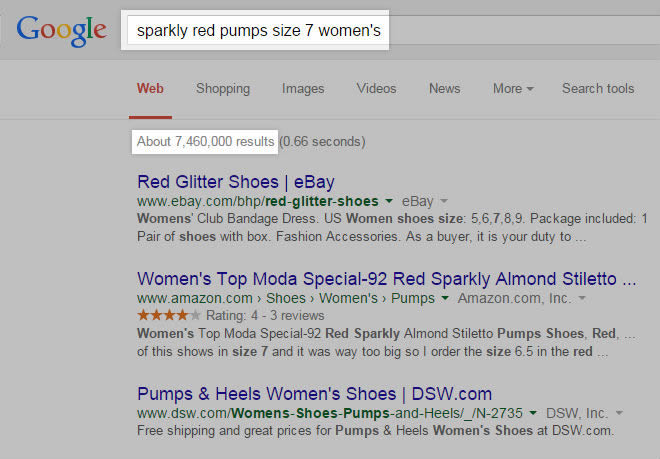
A recurring, overarching philosophy when it comes to search engine optimization is to cater to people, your visitors / shoppers, rather than focusing on generating traffic. While getting traffic to your site is generally good, getting the right kind of shopper to find your products is essential to your store’s success.
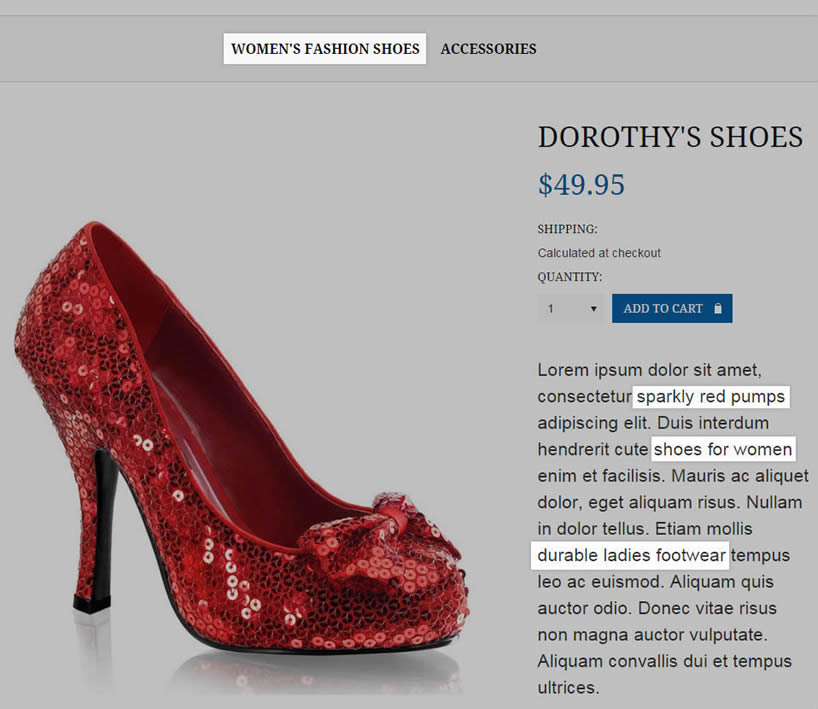
You'll need to dial in exactly how long your long tail keywords need to be. If they're too short, your content is lost in the millions of results returned. If they're too long, you won't get any traffic because almost nobody is being that specific.
Add long tail keywords to your store's content in a way that best serves and speaks to your shoppers. Do not just throw them on your site without context just to appease search engine crawlers. Search engines, especially Google, have become exceedingly better in the past few years at being able to discern between sites that are actually geared towards shoppers, and sites that are merely pandering to search engines in the hopes of generating traffic.
Think about how searchers phrase their queries, when researching keywords for your product or industry. They may not be as familiar with your market as you are, and might not use or understand industry terminology, slang or buzzwords.
How Keywords Work
A common misconception is that you need to get as much traffic to your website as possible. While you do need visitors, success is actually about attracting the right kind of visitors. It's also not enough to rank highly for keywords like “pottery” or “t-shirt”. These highly common search terms are referred to as "short tail keywords", and only make up around 30% of all searches.
The other 70% of search queries are “long tail keywords”, which are usually longer and more specific. Long tail keywords typically convert better, because they're searched for by people who are ready to buy. A person searching for "t-shirt" might just be killing time online, but someone searching for "best price Star Wars graphic tee" is likely to have their credit card out already.
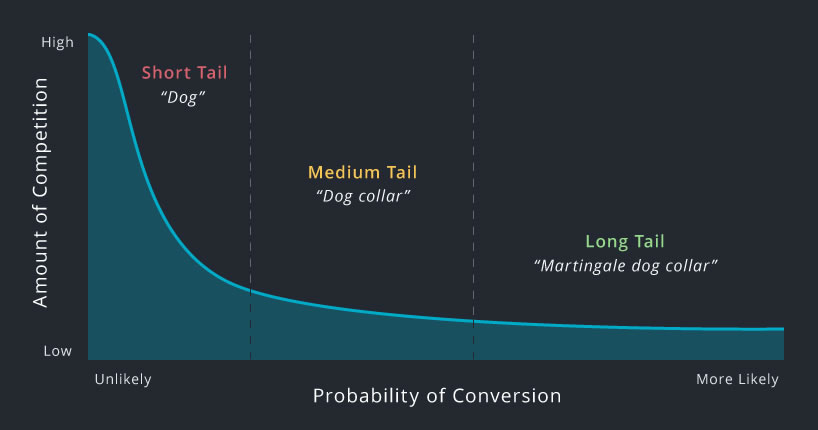
Consumers using a search engine are typically in one of three modes:
Browsers: These searchers are just exploring — they don't necessarily have a specific goal. They might search for funny cat videos or the history of Japan. They use short, non-descriptive search queries like "cat" or "Japanese history". These searches return hundreds of millions of results, making it hard to compete and be found.
Researchers: Searchers in research mode have a specific topic in mind, and are actively seeking more information on it. This could be someone considering purchasing a camera, and looking up reviews and specifications for a particular model. People in this mode have slightly more specific queries, like "Nikon camera reviews".
Buyers: As an online merchant, this is the mode you want shoppers to be in when they find your products. They are committed to making a purchase, and are performing a search in order to do so. Searchers in this mode are straightforward and detailed with their search queries, like "buy Nikon 16 megapixel digital SLR", "women's white long sleeve cashmere sweater", or "orange bamboo martingale dog collar". These searches return fewer results, meaning it's much more likely for your result to be shown.
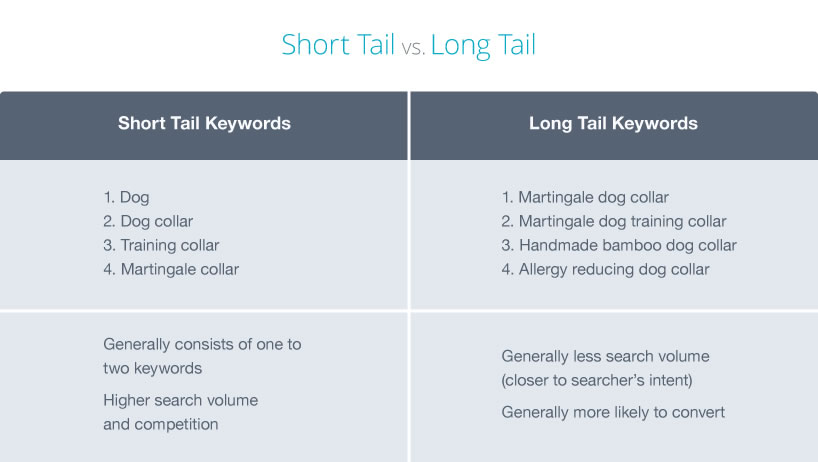
Here's the benefit of long tail keywords demonstrated in two photos:
Someone doing research on fashion trends might do a general search for "women's shoes", and will get literally millions of results.
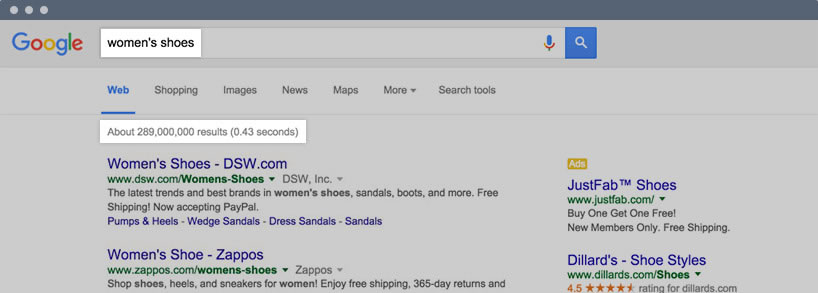
At the same time, someone who has zeroed in on what they want to buy will do a search for "sparkly red pumps size 7", and receive fewer but far more relevant results.

By uncovering the longer, more specific search terms used by people looking to buy, you can optimize your online store's pages to best speak to shoppers and rank with search engines. Here is a simple example of keyword targeting in a product page:

Page Titles
A Page Title is one of the most important on-page ranking factors and should be treated with care. Your page title tag shows up in Search Engine Result Pages (SERPs).
Search engines such as Google, Yahoo, and Bing use the title tag as the search results' title for that page.
SYNTAX OF A PAGE TITLE TAG
Every page of your website should have unique title tag, preferably starting with a relevant keyword. Unless you are a well-recognized brand, such as Nike, you should not include your company's name in your title tag. It is important that the keywords are also found within the copy(content) of your page - that means the keywords used in the title tag should match the keywords found on your site.
The length of a title shouldn't be longer than 60 characters. If it is, the search engine will show an ellipsis(...) at the end of the title.
Take a look at these two examples of title tags for a page that uses blue t-shirts as its main keyword phrase.
- Blue T-Shirts at Discounted Prices for Sale | BunchOfTshirts
- BunchOfTshirts | Discounts on blue and red t-shirts
The first example is the best, as it follows all of the rules mentioned earlier. It has the main keyword at the beginning of the title tag and is not broken into parts by other words, as seen in the second example. Words that break up the main keyword or phrase are called stop words and should be avoided. Also note that in the second example, the company name is found at the beginning of the title which again, is not advisable unless you are a well-known brand.
Meta Descriptions
The purpose of a meta description tag is to provide a brief and concise summary of your website's content. Search Engines often display meta description tags in the Search Engine Result Pages (SERPs). These descriptions provide an introduction to your web site that will likely determine whether a person decides to visit your page or bypass it. Therefore, the better your meta description tags are, the greater the likelihood that a person will actually click on your link and visit your website.
SYNTAX OF A META DESCRIPTION TAG
There are a few important things to keep in mind when writing meta description tags for your web page.
- Each page of your website should have a unique meta description describing the content found on that page.
- Keep your meta description below 160 characters. If you make it longer, search engines may not display it in full.
- If you are targeting specific keywords, make sure to include them at the beginning of the tag.
- A meta description tag should be well composed, compelling and informative. Think of it as an advertisement. A well composed meta description tag will most likely increase your website's Click-Through Rate (CTR) - the number of times your link is clicked, divided by the number of impressions (the number of times your link is displayed in the Search Engine Result Pages (SERPs) every time a specific search is performed by a user)
10 Long Tail Keywords
"Monthly Task and Responsibilities"
Off-Page Work Activities
Directory Submissions
On-Page Work Activities
Meta tags/Title tag changes
Keyword research/Analysis
Competitor Analysis
Heading tag changes
Alt tag changes
Keyword density on site
HTML Site Map
XML site map and Submission in webmaster tool
Ror.XML File creation
Robots.Txt File creation Extra work activities
Google Webmaster tool
Google Analytics
400 word SEO optimized press release
(samples)
Reporting
Competitor Rankings (3 competitors)

Social Media Management
Email Marketing
Up To 500 Contacts
Quarterly Newsletter Creation
No Contract Cancel Anytime
20 Long Tail Keywords
"Monthly Task and Responsibilities"
Off-Page Work Activities
Directory Submissions
On-Page Work Activities
Meta tags/Title tag changes
Keyword research/Analysis
Competitor Analysis
Heading tag changes
Alt tag changes
Keyword density on site
HTML Site Map
XML site map and Submission in webmaster tool
Ror.XML File creation
Robots.Txt File creation Extra work activities
Google Webmaster tool
Google Analytics
400 word SEO optimized press release
(samples)
Reporting
Competitor Rankings (5 competitors)

Social Media Management
Email Marketing
Up To 500 Contacts
Quarterly Newsletter Creation
No Contract Cancel Anytime


Call Us Today! 478-922-8979 For Your Free Initial Consultation
M-F 9:00a - 5:00p est.



